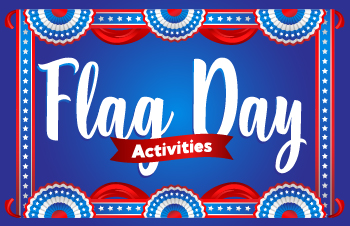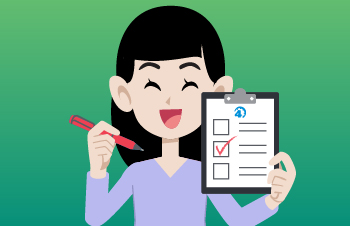3rd Grade Reading Strategy and Curriculum Standards
An essential part of the 3rd grade reading strategy is development of writing skill along with reading skill. Students use language arts worksheets created to help them write clear and coherent sentences and paragraphs that develop central ideas. These third grade language arts lessons encourage children to consider the audience they write for and to understand the purpose of their writing. The reading teacher guides students through researching, choosing a focus, prewriting, drafting, revising, and editing several versions. Various types of reference materials will be part of this language arts activity, including dictionaries, thesauruses, atlases, and encyclopedias.
Part of the 3rd grade reading strategy is for children to understand and be able to use complete and correct declarative, interrogative, imperative, and exclamatory sentences in writing and speaking.
3rd Grade Reading Strategy and Curriculum Standards: Grammar and Punctuation
Good grammar is important for 3rd grade students too. This year they will use language arts worksheets to learn to identify subjects and verbs that are in agreement and identify and use pronouns, adjectives, compound words, and articles correctly in writing and speaking. Another 3rd grade language arts activity is to identify and use past, present, and future verb tenses properly in writing and speaking. 3rd grade students are trained to use subjects and verbs correctly in speaking and writing simple sentences.
Punctuation learned this year includes the use of commas in dates, locations, and addresses, and for items in a series. Children are also expected to punctuate dates, city and state, and titles of books correctly when completing their language arts lessons. The 3rd grade reading strategy emphasizes the need to capitalize geographical names, holidays, historical periods, and special events correctly. At this reading skill level children are taught to spell one-syllable words that have blends, contractions, compounds, orthographic patterns (e.g., qu, consonant doubling, changing the ending of a word from -y to -ies when forming the plural), and common homophones (e.g., hair-hare), and to arrange words in alphabetic order.

In third grade language arts extensions, Carlos learns about good listening skills in Ruff's Road to Good Listening.
In this lesson, students are asked to identify keywords in example sentences.
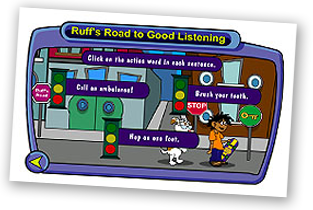
3rd Grade Reading Strategy and Curriculum Standards: Writing Applications
The 3rd grade reading strategy teaches students to create single paragraphs by developing topic sentences, including simple supporting facts and details. Students must write legibly in cursive or joined italic, allowing margins and correct spacing between letters in words, and words in a sentence. Good penmanship is an important part of any language arts activity.
Language arts lessons for 3rd grade students include development of reading skill by writing compositions that describe and explain familiar objects, events, and experiences. The 3rd grade reading strategy guides them, using, for example, language arts worksheets, to write narratives, providing a context within which an action takes place. Children are expected to include well-chosen details to develop the plot and to provide insights into why selected incidents are memorable. Elements of this language arts activity include writing descriptions that use concrete sensory details to present and support unified impressions of people, places, things, or experiences. Students are expected to use standard English conventions appropriate for 3rd grade when working on these language arts lessons.
Another language arts activity that develops reading skill is the writing of personal and formal letters, thank-you notes, and invitations. These should show an awareness of the knowledge and interests of the audience and establish a purpose and context, and should include the date, proper salutation, body, closing, and signature.

In third grade language arts, Paul Bunyan's Blue Ox Babe teaches about Tall Tales in the lesson Tall Tale Squares.
In this lesson, students are asked to answer a riddle using clues within a picture.
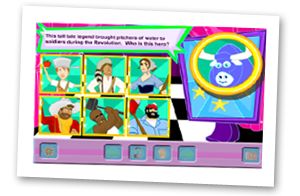
3rd Grade Language Arts Lessons, Language Arts Worksheets, Language Arts Activity
The 3rd Grade reading strategy includes development of listening and speaking skills. This language arts activity adds to a child’s reading skill as they learn to listen critically and respond appropriately to oral communication. Language arts lessons help them speak in an easily understood manner. This year students demonstrate reading comprehension by retelling, paraphrasing, and explaining what has been said by a speaker. Students are expected to listen critically and respond appropriately to oral communication. They should speak using proper phrasing, pitch, and modulation so that a listener will understand important ideas. During comprehension testing, 3rd grade language arts worksheets may be used to help children analyze the purpose of listening. For example they may be asked to connect and relate prior experiences, insights, and ideas to those of a speaker. Students are expected to respond to questions with appropriate elaboration. The 3rd grade reading strategy includes identification of musical elements in literary language, for example, rhymes, repeated sounds, and instances of onomatopoeia.
3rd grade students deliver brief recitations and oral presentations about familiar experiences or interests that are organized around a coherent thesis statement. Language arts lessons teach students speakers to organize ideas chronologically or around major points of information. They are expected to provide a beginning, a middle, and an end, including concrete details that develop a central idea, and to use clear and specific vocabulary to communicate ideas and establish the tone. One language arts activity is to clarify and enhance oral presentations through the use of appropriate props such as objects, pictures, or charts. These narrative presentations require that a 3rd grade child provide a context for an incident that is the subject of the presentation, provide insight into why the selected incident is memorable, and include well-chosen details to develop character, setting, and plot.
Another part of the 3rd grade reading strategy is for children to read prose and poetry aloud with fluency, rhythm, and pace. Using appropriate intonation and vocal patterns, they should emphasize important passages of a text being read. Yet another 3rd grade reading strategy language arts activity is to have students compare ideas and points of view expressed in broadcast and print media. They will need to distinguish between the speaker’s opinions and verifiable facts. In doing this, 3rd grade language arts worksheets may help students organize their thoughts. Children enrolled in a 3rd grade reading strategy program will be asked to plan and present dramatic interpretations of experiences, stories, poems, or plays, using clear diction, pitch, tempo, and tone. They will make descriptive presentations that use concrete sensory details to set forth and support unified impressions of people, places, things, or experiences. All these components of the 3rd grade reading strategy help children develop greater reading skill.
More: 3rd Grade Spelling Words.
*Reading Standards are defined by each state. Time4Learning bases its use of 3rd Grade reading standards on the national bodies that recommend curriculum and standards and the interpretations of it by a sampling of states notably Florida, Texas, and California.
Lesson Activity Finder Tool
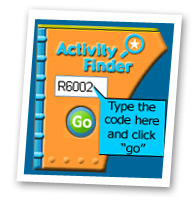 The lesson activity finder is one of the many helpful tools that Time4Learning offers its members. The activity finder is a shortcut that makes it easy for parents to preview lessons or find extra practice for their child.
The lesson activity finder is one of the many helpful tools that Time4Learning offers its members. The activity finder is a shortcut that makes it easy for parents to preview lessons or find extra practice for their child.
Every lesson in the curriculum has a unique activity number, referred to in the lesson plans as an “LA Number.” These numbers can be found on either the scope and sequence pages or the lesson plans in the Parent Dashboard.
The activity finder can be found in the lower left hand corner of the Student Dashboard. To use it, members simply log in to their child’s account, type the Learning Activity (LA) number of a lesson into the Activity Finder and click “Go” to open it.





